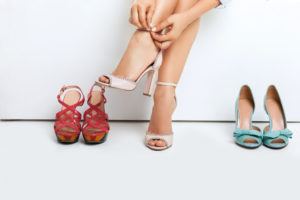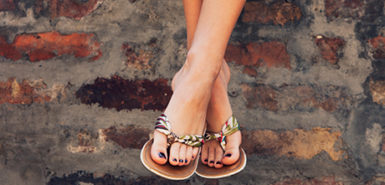
Like many women, Marisha Stawiski, DPM, would love to be able to wear a 3-inch heel on a regular basis with no pain.
“But unfortunately, the vast majority of us just cannot withstand this foot position for any prolonged course of time on a regular basis without having detrimental effects on foot health and eliciting pain,” said the Spectrum Health Medical Group Foot & Ankle podiatrist. “As a rule of thumb, the more you can avoid a shoe with a heel over 1.5 inches, the better.
“Yet many of us (myself included) will stray from this rule of thumb for aesthetics and beauty at times,” Dr. Stawiski said. “Some of us more than others.”
Her best advice?
1. Go high quality.
Buy a heel that is as high quality as possible for your budget. Certainly, something with more cushion, width and arch support will feel better than a poorly constructed shoe.
2. Go lower.
The lower the heel, the less you are going to see complications and pain associated with wear. Think a cute kitten or wedge heel.
3. Try it out.
Purchase the shoe only if you can return it. If you wear it around your home only an hour or two (don’t wear outside, stay on carpet), you will know if there is any way the heel will be something you can feasibly wear for an extended period of time and still be modestly comfortable.
4. Keep it real.
If you have certain foot pathology, sadly, you may need to give up the idea of wearing heels at all. Some examples of pathology that may preclude you from being able to wear high heels includes severe bunions or hammertoes, arthritis, hallux rigidus, or Haglund’s deformity.
5. Give your feet a timeout.
Whenever possible, avoid wearing high heels for any extended walking or standing. Bring an alternative pair of shoes with you to the office, and slip off your heels under the desk during the day to put on a more sensible shoe. Slip on your heels when getting up for meetings, but try to avoid staying in them all day long. Take them off for your commute as well.
6. Think special occasions.
Avoid wearing heels on a regular basis or every day. Have alternative wardrobes that go well with a lower heel, wedge or a flat with more support. Your feet really do need a break from wearing a high heel, and high heels should be more of an occasional thing than an everyday occurrence.
Higher risks
Remember, if you choose to wear high heels, you are at a higher risk of developing a variety of conditions, including metatarsal pain, plantar fasciitis, Achilles tendon issues, Haglund’s deformity and knee pain.
“There is plenty of data to show that high heels have negative long-term effects on several structures from the toes all the way up the lower extremity,” Dr. Stawiski said.
While some shoemakers market technology such as memory foam and built-in arch support that’s meant to diminish the problems associated with high-heel use, it doesn’t change the position of the foot when it’s stuffed into a heel.
“All high heels are thrusting the foot into a very unnatural position,” Dr. Stawiski said. “You cannot completely counteract the negative affects of walking or standing in heels with new technology.”
Even if considerable padding and arch support are added to a 3-inch-plus heel, the issues with the high heel still exist, she noted.
“Padding and arch support don’t change this abnormal biomechanical position, which creates many of the injuries associated with wearing high heels,” she said. “These added technologies can make the shoe more tolerable for a longer amount of time for certain individuals, but they do not eliminate the root issues inherent to a high heel.”
 /a>
/a>
 /a>
/a>
 /a>
/a>